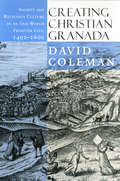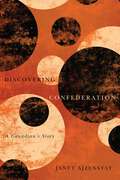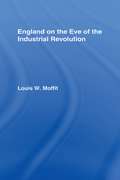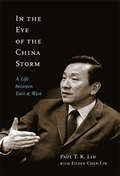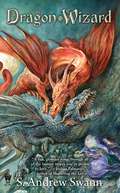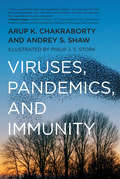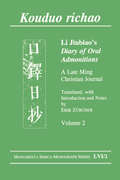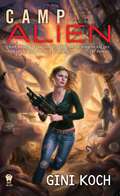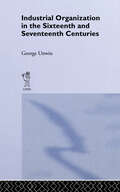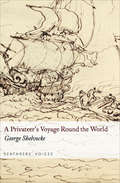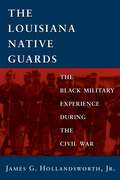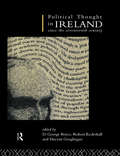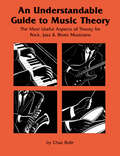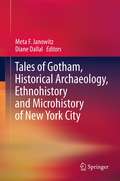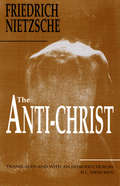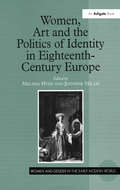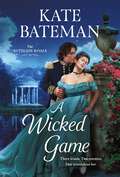- Table View
- List View
Creating Christian Granada
by David ColemanCreating Christian Granada provides a richly detailed examination of a critical and transitional episode in Spain's march to global empire. The city of Granada-Islam's final bastion on the Iberian peninsula-surrendered to the control of Spain's "Catholic Monarchs" Isabella and Ferdinand on January 2, 1492. Over the following century, Spanish state and Church officials, along with tens of thousands of Christian immigrant settlers, transformed the formerly Muslim city into a Christian one. With constant attention to situating the Granada case in the broader comparative contexts of the medieval reconquista tradition on the one hand and sixteenth-century Spanish imperialism in the Americas on the other, Coleman carefully charts the changes in the conquered city's social, political, religious, and physical landscapes. In the process, he sheds light on the local factors contributing to the emergence of tensions between the conquerors and Granada's formerly Muslim, "native" morisco community in the decades leading up to the crown-mandated expulsion of most of the city's moriscos in 1569-1570. Despite the failure to assimilate the moriscos, Granada's status as a frontier Christian community under construction fostered among much of the immigrant community innovative religious reform ideas and programs that shaped in direct ways a variety of church-wide reform movements in the era of the ecumenical Council of Trent (1545-1563). Coleman concludes that the process by which reforms of largely Granadan origin contributed significantly to transformations in the Church as a whole forces a reconsideration of traditional "top-down" conceptions of sixteenth-century Catholic reform.
England on the Eve of Industrial Revolution
by Louis W. MoffitPublished in the year 1963, England on the Eve of the Industrial Revolution is a valuable contribution to the field of Economics.
Expect Miracles: Recollections of a Lucky Life
by David M. CulverExpect Miracles is the personal and professional story of a leader in the worlds of business and culture. David Culver narrates his journey from his upbringing in Montreal's Golden Square Mile, through his studies at McGill and Harvard, his army service during the Second World War, to his impressive rise at Alcan to become chairman and chief executive officer of one of Canada's leading multinational corporations. The memoir provides an inside look into the management of a global company with roots deeply planted in Quebec and offers pragmatic advice on how to grow talent, foster technology, and handle adversity in a far-flung organization. Anecdotes of meeting the likes of Margaret Thatcher, Henry Kissinger, and Jawaharlal Nehru, reveal the experiences of a strong corporate leader who continued to live a Montreal life, while never losing his interest in discovering the world. A man of many interests and talents, Culver reflects on his long love affair with architecture - and his efforts to restore and preserve Montreal's heritage by creating Maison Alcan - and how music and sport helped shape his life. Expect Miracles is evidence of Culver's positive outlook and belief that the most extraordinary things can happen when you least expect them.
Georges and Pauline Vanier
by Mary Frances CoadyGeorges and Pauline Vanier follows their lives and travels across the world - from Canadian military life to the League of Nations, from the inner circles of British government to their harrowing escape from Nazi-occupied France - detailing their disappointments and triumphs during social and political turbulence. With insight and sympathy, Mary Frances Coady tells their dramatic personal story. Revealing their remarkably vibrant personalities, she details the couple's support of the French resistance as well as Georges Vanier's pleas for the Canadian government to accept refugees fleeing Hitler's horrors and his effort to broaden immigration policy. She also recounts the importance of their religious convictions, their controversial standing among Quebecers, and their early advocacy of official bilingualism. An invigorating and well-told tale of their lasting legacies, Georges and Pauline Vanier is the definitive account of the enduring contributions the Vaniers made to the world and to their country.
In the Eye of the China Storm
by Eileen Chen Lin Paul T. K. LinBorn in Vancouver in 1920 to immigrant parents, Lin became a passionate advocate for China while attending university in the United States. With the establishment of the People's Republic, and growing Cold War sentiment, Lin abandoned his doctoral studies, moving to China with his wife and two young sons. He spent the next fifteen years participating in the country's revolutionary transformation. In 1964, concerned by the political climate under Mao and determined to bridge the growing divide between China and the West, Lin returned to Canada with his family and was appointed head of McGill University's Centre for East Asian Studies. Throughout his distinguished career, Lin was sought after as an authority on China. His commitment to building bridges between China and the West contributed to the establishment of diplomatic relations between Canada and China in 1970, to US President Richard Nixon's visit to China in 1972, and to the creation of numerous cultural, academic, and trade exchanges. In the Eye of the China Storm is the story of Paul Lin's life and of his efforts - as a scholar, teacher, business consultant, and community leader - to overcome the mutual suspicion that distanced China from the West. A proud patriot, he was devastated by the Chinese government's violent suppression of student protestors at Tiananmen Square in June 1989, but never lost faith in the Chinese people, nor hope for China's bright future.
Dragon Wizard (Dragon Princess #3)
by S. Andrew SwannIt has been a year since former thief Frank Blackthorne became Princess of Lendowyn and married a dragon. He's coming to terms with his new life, but during the royal anniversary banquet, an elven prince reads a scroll of evil magic and Frank's world is turned upside-down. Again. The scroll's spell causes a murderous rampage in a palace full of noble dignitaries, so it's no surprise Frank's visitors are angry. The Elf-King Timoras threatens war but Frank can't do anything about it: because of the same bit of scroll magic, the ex-Dragon Lucille has taken over the princess's body, unaware that Frank is still there, locked in her skull. And worst of all, the fate of everyone may soon rest on the shoulders of the man responsible for the whole mess, someone who should be safely dead...
Viruses, Pandemics, and Immunity
by Arup K. Chakraborty Andrey ShawHow viruses emerge to cause pandemics, how our immune system combats them, and how diagnostic tests, vaccines, and antiviral therapies work.Throughout history, humans have contended with pandemics. History is replete with references to plagues, pestilence, and contagion, but the devastation wrought by pandemics had been largely forgotten by the twenty-first century. Now, the enormous human and economic toll of the rapidly spreading COVID-19 disease offers a vivid reminder that infectious disease pandemics are one of the greatest existential threats to humanity. This book provides an accessible explanation of how viruses emerge to cause pandemics, how our immune system combats them, and how diagnostic tests, vaccines, and antiviral therapies work-- concepts that are a foundation for our public health policies.
Kouduo richao. Li Jiubiao's Diary of Oral Admonitions. A Late Ming Christian Journal: Translated, with Introduction and Notes by Erik Zurcher, Vol. 2
by Erik ZürcherThe Diary of Oral Admonitions (Kouduo richao) is an invaluable mirror of early Chinese Christianity, as it stands out as the only source that allows a glimpse of Jesuit missionary practice in China on a local level - "accommodation in action" - and of the various responses of the Chinese audience, both converts and interested outsiders. It is a compilation of some five hundred notes "about everything" made by Li Jiubiao and other Christian literati during their conversations with Jesuit missionaries in Fujian between 1630 and 1640. These notes are arranged in chronological order and divided into eight books. The most important Western protagonist in the Diary is the Italian Jesuit Giulio Aleni (1589-1642), called "Master Ai (Rulüe)" in Chinese. The present study and translation of the Diary of Oral Admonitions can be seen as a companion volume to the proceedings of an international conference that was held on Aleni in his native place Brescia in 1994, also published in the Monumenta Serica Monograph Series XLII: "Scholar from the West." Giulio Aleni S.J. (1582-1649) and the Dialogue between China and Christianity, 1997. The present work in two volumes is meant to be a tool for further research. Volume 1 presents a comprehensive introduction to the Diary and its historical context, followed by the annotated translation, both by Erik Zürcher (Leiden), a renown specialist for the study of Christianity in China. It is enhanced by illustrations, partly in colour, and maps. Volume 2 includes a facsimile of the Chinese text (reproducing a copy held in the Roman Archives of the Society of Jesus), a bibliography of Chinese and Western sources as well as secondary literature, and an analytical index with glossary that will enable the reader to trace specific data in the text.
The Economic Aspects of the History of the Civilization of Japan (Routledge Library Editions)
by Yosaburo TakekoshiOriginally published by Allen & Unwin in 1930 this 3-volume collection brings together writings on the economic aspects of Japan's history. Covering the period from the 1600s until the 1920s this work offers the reader, not only an economic history of the Japanese, but also a social and political history. By explaining the realities of daily life during the periods covered, this collection allows the economic aspects to be fully appreciated.
Camp Alien: Alien Novels, Book 13 (Alien Novels #13)
by Gini KochThe President and First Lady, aka Jeff and Kitty Katt-Martini, don't get any downtime once the Mastermind has been revealed to the world. Not only do they have myriad high-level government positions to fill, but the scrutiny and pressure on this Administration has gone into overdrive.The sudden reappearance of a long-forgotten adversary turns out to be the tip of the iceberg. New robots and androids attacking, old enemies making new alliances, and new aliens with interesting abilities almost overshadow the fact that the U.S. still has to host a peace summit at Camp David between Israel and Iraq. It's clear that while the Mastermind may be down, there are plenty of others ready to take his place--and all that stands between them and success are Kitty and Company.Kidnappings, rescues, creepy hideouts, a hidden black site, and a domestic dispute that could end Jeff and Kitty's marriage are nothing compared to finding not one but two hidden labs where dangerous and deadly things are brewing. But when the President and his entourage finally get to the peace talks, things are no better. Mossad rightly suspects something's wrong with both their Prime Minister and the President of Iraq. A hidden in-control superbeing, an android replacement, and an army of Fem-Bots turn the peace talks into a Battle Royale that the team might not actually survive. And if they don't make it, Earth won't make it, either.But no pressure.
Industrial Organization in the Sixteenth and Seventeenth Centuries: Unwin, G. (Routledge Revivals Ser.)
by George UnwinFirst Published in 1963. Routledge is an imprint of Taylor & Francis, an informa company.
A Privateer's Voyage Round the World (Seafarers' Voices)
by George ShelvockeIn 1719, Captain George Shelvocke, a poverty-stricken ex-naval officer, appealed for help to an old shipmate, Edward Hughes, who was then part of a consortium fitting-out two privateering vessels to prey on the Spanish in the Pacific. He offered Shelvocke the captaincy of the larger ship but then demoted him to a smaller vessel, and Shelvocke, bitter and revengeful, immediately set off on his own for South America with a semi-mutinous crew, and his much-hated Captain of Marines, William Betagh. After rounding Cape Horn, one of Shelvockes men shot a black albatross an event later to be immortalised in Coleridges Rime of the Ancient Mariner and then, off Chile, with considerable loot onboard his ship, the Speedwell, was wrecked in the Juan Fernandez Islands. Undaunted, he built another vessel and eventually returned to England, via Macao, loaded with Spanish plunder. Back home he was arrested for piracy and defrauding his shareholders, though he argued that he owed the original owners nothing as their ship had been honestly lost. The events were grippingly portrayed in his memoir A Voyage Round the World by Way of the Great South Sea, though some of it was disputed by Betagh and others, and it still reads today as a fast moving, incident-packed tale exposing the world of the maritime mercenaries and privateers, men who would take on anything and everything for Gold!
Adult Psychological Problems: An Introduction (Contemporary Psychology Ser. #Vol. 5)
by Michael Power Lorna ChampionFirst published in 2000. Routledge is an imprint of Taylor & Francis, an informa company.
Slavery and Augustan Literature: Swift, Pope and Gay (Routledge Studies in Eighteenth-Century Literature)
by Dr J RichardsonSlavery and Augustan Literature investigates slavery in the work of Jonathan Swift, Alexander Pope and John Gay. These three writers were connected with a Tory ministry, which attempted to increase substantially the English share of the international slave trade. They all wrote in support of the treaty that was meant to effect that increase. The book begins with contemporary ideas about slavery, with the Tory ministry years and with texts written during those years. These texts tend to obscure the importance of the slave trade to Tory planning. In its second half, the book analyses the attitudes towards slavery in Pope's Horatian poems, An Essay on Man, Polly, A Modest Proposal and Gulliver's Travels. John Richardson shows how, despite differences, Swift, Pope and Gay adopt a mixed position of admiration for freedom alongside implicit support for slavery.
The Louisiana Native Guards: The Black Military Experience During the Civil War
by James G. Hollandsworth Jr.Early in the Civil War, Louisiana's Confederate government sanctioned a militia unit of black troops, the Louisiana Native Guards. Intended as a response to demands from members of New Orleans' substantial free black population that they be permitted to participate in the defense of their state, the unit was used by Confederate authorities for public display and propaganda purposes but was not allowed to fight. After the fall of New Orleans, General Benjamin F. Butler brought the Native Guards into Federal military service and increased their numbers with runaway slaves. He intended to use the troops for guard duty and heavy labor. His successor, Nathaniel P. Banks, did not trust the black Native Guard officers, and as he replaced them with white commanders, the mistreatment and misuse of the black troops steadily increased. The first large-scale deployment of the Native Guards occurred in May, 1863, during the Union siege of Port Hudson, Louisiana, when two of their regiments were ordered to storm an impregnable hilltop position. Although the soldiers fought valiantly, the charge was driven back with extensive losses. The white officers and the northern press praised the tenacity and fighting ability of the black troops, but they were still not accepted on the same terms as their white counterparts. After the war, Native Guard veterans took up the struggle for civil rights—in particular, voting rights—for Louisiana's black population. The Louisiana Native Guards is the first account to consider that struggle. By documenting their endeavors through Reconstruction, James G. Hollandsworth places the Native Guards' military service in the broader context of a civil rights movement that predates more recent efforts by a hundred years. This remarkable work presents a vivid picture of men eager to prove their courage and ability to a world determined to exploit and demean them.
Green Jobs for a New Economy: State and Federal Workforce Training
by Peterson'SLooking for two-year schools with sustainability programs? These easy-to-read profiles are organized by state and province, and include the following information for accredited two-year schools in the United States, U.S. territories, and Canada that responded to Peterson's Survey of Sustainability Efforts in Higher Education online survey: Sustainability Initiatives, Academics, Student Services and Green Events, Food, Transportation, Buildings and Grounds, Recycling, Energy, Purchasing, and Contact Information. Featuring exclusive bonus section, "What Does Being Green Mean," which examines the current interest in sustainability, President Obama's "New Energy for America" program, and key green terms and definitions, with links to more than 20 green job boards and over 30 U.S. and global organizations that support sustainability.
Disease, Religion and Healing in Asia: Collaborations and Collisions
by Zhou Xun Ivette M. Vargas-O'BryanRecent academic and medical initiatives have highlighted the benefits of studying culturally embedded healing traditions that incorporate religious and philosophical viewpoints to better understand local and global healing phenomena. Capitalising on this trend, the present volume looks at the diverse models of healing that interplay with culture and religion in Asia. Cutting across several Asian regions from Hong Kong to mainland China, Tibet, India, and Japan, the book addresses healing from a broader perspective and reflects a fresh new outlook on the complexities of Asian societies and their approaches to health. In exploring the convergences and collisions a society must negotiate, it shows the emerging urgency in promoting multidisciplinary and interdisciplinary research on disease, religion and healing in Asia. Drawing on original fieldwork, contributors present their latest research on diverse local models of healing that occur when disease and religion meet in South and East Asian cultures. Revealing the symbiotic relationship of disease, religion and healing and their colliding values in Asia often undetected in healthcare research, the book draws attention to religious, political and social dynamics, issues of identity and ethics, practical and epistemological transformations, and analogous cultural patterns. It challenges the reader to rethink predominantly long-held Western interpretations of disease management and religion. Making a significant contribution to the field of transcultural medicine, religious studies in Asia as well as to a better understanding of public health in Asia as a whole, it will be of interest to students and scholars of Health Studies, Asian Religions and Philosophy.
Political Thought in Ireland Since the Seventeenth Century
by Robert Eccleshall Vincent Geoghegan D. George BoyceThese pioneering essays provide a unique study of the development of political ideas in Ireland from the seventeenth to the twentieth century. The book breaks away from the traditional emphasis in Irish historiography on the nationalism/unionism debate to focus instead on previously neglected areas such as the role of the Scottish Enlightenment and early Irish socialism and conservatism. A wide range of original primary sources are used from pamphlets to journalism, devotional tracts to poetry.
An Understdable Guide to Music Theory: The Most Useful Aspects of Theory for Rock, Jazz, and Blues Musicians
by Chaz BufeThis guide explains the most useful aspects of theory in clear, nontechnical language. Areas covered include scales (major, minor, modal, synthetic), chord formation, chord progression, melody, song forms, useful devices, (ostinato, mirrors, hocket, etc.), and instrumentation. It contains over 100 musical examples.
Tales of Gotham, Historical Archaeology, Ethnohistory and Microhistory of New York City
by Meta F. Janowitz Diane DallalHistorical Archaeology of New York City is a collection of narratives about people who lived in New York City during the seventeenth, eighteenth, and nineteenth centuries, people whose lives archaeologists have encountered during excavations at sites where these people lived or worked. The stories are ethnohistorical or microhistorical studies created using archaeological and documentary data. As microhistories, they are concerned with particular people living at particular times in the past within the framework of world events. The world events framework will be provided in short introductions to chapters grouped by time periods and themes. The foreword by Mary Beaudry and the afterword by LuAnne DeCunzo bookend the individual case studies and add theoretical weight to the volume. Historical Archaeology of New York City focuses on specific individual life stories, or stories of groups of people, as a way to present archaeological theory and research. Archaeologists work with material culture--artifacts--to recreate daily lives and study how culture works; this book is an example of how to do this in a way that can attract people interested in history as well as in anthropological theory.
The Anti-Christ
by H. L. Mencken Friedrich NietzscheThis is Nietzsche's last book and a fitting capstone to his career. It's succinct, biting, and encapsulates the criticisms of Christianity found in his other works. This edition contains an 8,000-word introduction by its translator, the famous iconoclastic writer H. L. Mencken.
The Philosophy of Friedrich Nietzsche
by H. L. MenckenThe first book on Nietzsche ever to appear in English, this examination by legendary journalist H. L. Mencken is still one of the most enlightening. Mencken wrote this book while still in his 20s, but his penchant for thoroughness was evident even at that young age--in preparation for writing this book, he read Nietzsche's works in their entirety, mostly in the original German. A brief biographical sketch is followed by clear and thorough explanations of Nietzsche's basic concepts and attitudes. Analyzed are Nietzsche's much-misunderstood concept of the superman, his concept of eternal recurrence, his rejection of Christianity, and his basic rationalism and materialism. Included are two essays on Nietzsche that appeared in Mencken's magazine The Smart Set subsequent to the publishing of the original edition of this book. Nearly a century after its original publication, this remains one of the clearest, most concise, and entertaining introductions to Nietzsche to date.
Women, Art and the Politics of Identity in Eighteenth-Century Europe (Women and Gender in the Early Modern World)
by Melissa HydeThe eighteenth century is recognized as a complex period of dramatic epistemic shifts that would have profound effects on the modern world. Paradoxically, the art of the era continues to be a relatively neglected field within art history. While women's private lives, their involvement with cultural production, the project of Enlightenment, and the public sphere have been the subjects of ground-breaking historical and literary studies in recent decades, women's engagement with the arts remains one of the richest and most under-explored areas for scholarly investigation. This collection of new essays by specialist authors addresses women's activities as patrons and as "patronized" artists over the course of the century. It provides a much needed examination, with admirable breadth and variety, of women's artistic production and patronage during the eighteenth century. By opening up the specific problems and conflicts inherent in women's artistic involvements from the perspective of what was at stake for the eighteenth-century women themselves, it also acts as a corrective to the generalizing and stereotyping about the prominence of those women, which is too often present in current day literature. Some essays are concerned with how women's involvement in the arts allowed them to fashion identities for themselves (whether national, political, religious, intellectual, artistic, or gender-based) and how such self-fashioning in turn enabled them to negotiate or intervene in the public domains of culture and politics where "The Woman Question" was so hotly debated. Other essays examine how men's patronage of women also served as a vehicle for self-fashioning for both artist and sponsor. Artists and patrons discussed include: Carriera; Queen Lovisa Ulrike and Chardin; the Bourbon Princesses Mlle Clermont, Mme Adélaïde and Nattier; the Duchess of Osuna and Goya; Marie-Antoinette and Vigée-Lebrun; Labille-Guiard; Queen Carolina of Naples, Prince Stanislaus Poniatowski of Poland and Kauffman; David and his students, Mesdames Benoist, Lavoisier and Mongez.
A Wicked Game: The Ruthless Rivals (Ruthless Rivals #3)
by Kate BatemanA Wicked Game marks the third book in Kate Bateman's popular regency romance series, Ruthless Rivals.If there’s one thing impossible for a Davies to resist, it’s a challenge from a Montgomery. . .A teasing bet.Shipwrecked and imprisoned thanks to an incorrect map, Captain Morgan Davies has returned to London to exact sweet revenge on the cartographer responsible for his suffering. He’s also vowed to claim the winner’s prize—three kisses—in the bet he made with his long-time nemesis, the prickly, smart-mouthed Harriet Montgomery. His incarceration has clarified his feelings for her, but convincing the infuriating woman he wants to marry her is going to be his greatest challenge yet. When Harriet’s revealed to be the very mapmaker he seeks, Morgan decides to combine revenge and seduction into one delightful package. . . A dangerous enemy.Harriet’s always wanted witty scoundrel Morgan, and now he’s back; as handsome and as taunting as ever. She has enough on her plate dealing with her father’s failing eyesight and a rival mapmaker copying her work to play wicked games with a dastardly Davies—however tempting he might be. But when a threat from Morgan’s past puts them both in danger, Harry discovers that she and Morgan might not be enemies at all . . .
